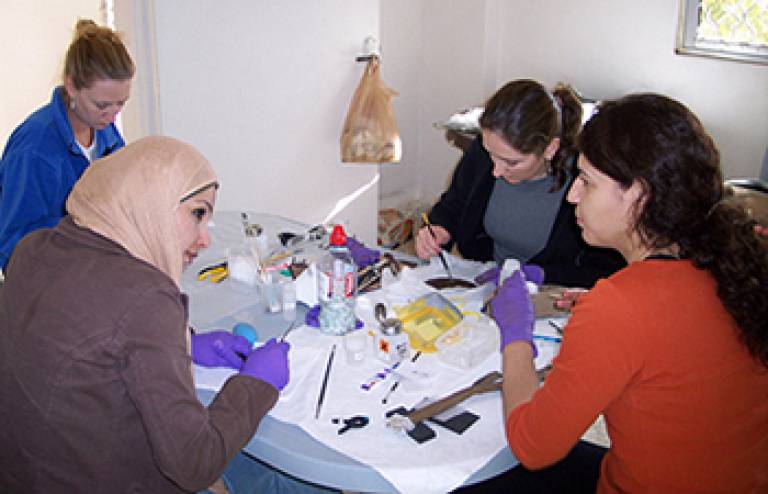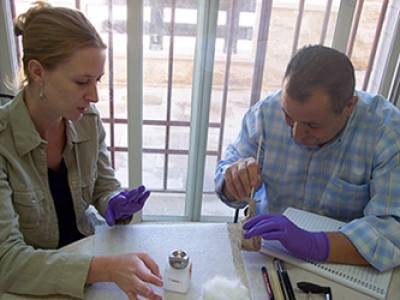Dusting off conservation in Jordan
4 April 2008
PhD student Melina Smirniou is one of the founding members of
 heritagewithoutborders.org/" target="_self">Heritage without Borders, set up last year by UCL conservation alumnae with the help of a UCL Futures grant to provide free conservation support to archaeological sites with inadequate funding. Here Melina describes the challenges and achievements of the team's recent six-site mission around Jordan.
heritagewithoutborders.org/" target="_self">Heritage without Borders, set up last year by UCL conservation alumnae with the help of a UCL Futures grant to provide free conservation support to archaeological sites with inadequate funding. Here Melina describes the challenges and achievements of the team's recent six-site mission around Jordan.
"Going to Kythera last year and going to Jordan this year were completely different experiences. Kythera [where the team treated objects in temporary storage after an earthquake] was a more familiar project: I am Greek and Cyprian Broodbank, co-director of the Kythera Island Project, is a professor at UCL. We dealt with objects from one very small museum with two employees in one site.
"The Jordan project came about through a UCL archaeology PhD student from Jordan who knows the director of the Department of Antiquities in Jordan. After a lot of discussion and negotiation, Christie Pohl, Amy Drago and I were invited to treat items from archaeological collections in Umm Qais, Jarash, Karak, Petra, Irbid and Amman over three weeks. In total, there was one young conservator in one of the museums. There was no equipment or tools, though there was room for small labs at each site. We didn't know what the condition of the artefacts would be, just that they would be mainly Roman and Islamic.
"The trip was planned very well for us. The Department of Antiquities provided accommodation in Jarash and in Petra, and everyone was very enthusiastic; we heard more archaeologists would like to have come. There is a general awareness of conservation but lack of resources.
"One of the main objectives of the trip was to try to train local people in conservation so that they could continue our work after we finished. We focused on preventive conservation: making sure objects are stored in good condition so that they don't have further damage. For example, in the storage rooms there is no equipment to control the environment, so we showed the curators, collections staff, students and archaeologists how to make a micro-environment by padding airtight Tupperware with acid-free tissue and silica gel - some of the many materials we took with us.
"At all the sites we advised on storage conditions, display methods and environmental control. These depend on how and where each object was buried and stored and what material they are. For example, the bronze objects had active corrosion so parts of the artefacts were green. If you don't clean them properly, the corrosion will eventually destroy the metal. This is worse in environments that have fluctuations in humidity.
"We stabilised and re-housed unstable metal and glass objects, and we even came across a big lead coffin at Jarash dating from the Roman period. We could have spent months dealing just with the coffin! It was corroded and very fragmentary; examining it gave us the opportunity to demonstrate how to handle lead safely, as it can be toxic.
"On our last day we gave a lecture and hands-on session at the Department of Antiquities headquarters in Amman about conservation techniques and our experiences with CWB. The best part of the trip was learning how to interact with a different culture. It was also the first time we had to treat objects and show to non-conservators best conservation practices - it's a challenge to get the balance right!

"We'll revisit in 2008, and we'll go back to Kythera next year too to finish up our work there. We have funding for next season, but not beyond that. It costs about £2,500 to take two to three qualified volunteer conservators and appropriate conservation-grade material to a single site for three weeks.
"There is a real need to teach people about basic conservation skills; it is becoming more common for conservators to work closely with archaeologists. In the future we would like to bring more volunteer conservators on each trip and a current UCL conservation student to help train them. Most important of all is sustainability: the local people must have the means to carry on the conservation after we have gone. This month CWB will present a paper at the annual meeting of the American Institute for Conservation of Historic and Artistic Works about our experiences.
"Right now I am working at the British Museum, conserving Greek and Roman objects and preparing items for an exhibition on Hadrian. I would like to thank the museum for giving me the time to pursue my Conservators without Borders work."
Image 1: Lina Bakker of the Dar As-Saray Museum in Irbid (front left) with (l-r) Christie Pohl, Amy Drago and Melina Smirniou
Image 2: Christie Pohl with Sate Massadeh of the Karak Archaeological Museum
By Lara Carim, UCL Communications
 Close
Close

